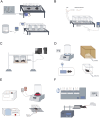Oxaliplatin-induced neuropathic pain in cancer: animal models and related research progress
- PMID: 40520182
- PMCID: PMC12162332
- DOI: 10.3389/fphar.2025.1609791
Oxaliplatin-induced neuropathic pain in cancer: animal models and related research progress
Abstract
Oxaliplatin, a third-generation platinum-based chemotherapeutic agent, has shown substantial efficacy in cancer treatment. However, its associated side effects, particularly chemotherapy-induced peripheral neuropathic pain (CIPNP), continue to challenge cancer survivors globally. Clinically, it frequently presents as numbness, coldness, and discomfort in the limbs and extremities. Duloxetine is advised for analgesic purposes. Despite its clinical relevance, both the application methods and the underlying mechanisms of oxaliplatin-induced CINP warrant further investigation. Consequently, more precise animal models are needed to explore the mechanisms and progression of this condition. This review consolidates recent advancements in rat and mouse models of oxaliplatin-induced CINP, with the aim of enhancing modeling success rates and developing models that more accurately mirror disease progression. Such models are essential for advancing clinical research and drug development.
Keywords: CINP animal model; applications; chemotherapy; neuropathic pain; oxaliplatin.
Copyright © 2025 Jiang, Shi, Wang, Piao, Yao, Yu, Zhai, Liu, Li, Fu, Shen, Jin and Li.
Conflict of interest statement
The authors declare that the research was conducted in the absence of any commercial or financial relationships that could be construed as a potential conflict of interest.
Figures





Similar articles
-
Huachansu suppresses TRPV1 up-regulation and spinal astrocyte activation to prevent oxaliplatin-induced peripheral neuropathic pain in rats.Gene. 2019 Jan 5;680:43-50. doi: 10.1016/j.gene.2018.09.035. Epub 2018 Sep 20. Gene. 2019. PMID: 30244138
-
Preventing oxaliplatin-induced neuropathic pain: Using berberine to inhibit the activation of NF-κB and release of pro-inflammatory cytokines in dorsal root ganglions in rats.Exp Ther Med. 2021 Feb;21(2):135. doi: 10.3892/etm.2020.9567. Epub 2020 Dec 10. Exp Ther Med. 2021. PMID: 33376517 Free PMC article.
-
Pharmacological Treatment of Chemotherapy-Induced Neuropathic Pain: PPARγ Agonists as a Promising Tool.Front Neurosci. 2019 Aug 28;13:907. doi: 10.3389/fnins.2019.00907. eCollection 2019. Front Neurosci. 2019. PMID: 31555078 Free PMC article. Review.
-
Huangqi Guizhi Wuwu Decoction can prevent and treat oxaliplatin-induced neuropathic pain by TNFα/IL-1β/IL-6/MAPK/NF-kB pathway.Aging (Albany NY). 2022 Jun 27;14(12):5013-5022. doi: 10.18632/aging.203794. Epub 2022 Jun 27. Aging (Albany NY). 2022. PMID: 35759577 Free PMC article.
-
Mechanism-based treatment for chemotherapy-induced peripheral neuropathic pain.Nat Rev Neurol. 2014 Dec;10(12):694-707. doi: 10.1038/nrneurol.2014.211. Epub 2014 Nov 4. Nat Rev Neurol. 2014. PMID: 25366108 Review.
References
-
- Agnes J. P., Dos Santos B., das Neves R. N., Luciano V. M. M., Benvenutti L., Goldoni F. C., et al. (2023). β-Caryophyllene Inhibits oxaliplatin-induced peripheral neuropathy in mice: role of Cannabinoid type 2 receptors, oxidative stress and neuroinflammation. Antioxidants (Basel) 12 (10), 1893. 10.3390/antiox12101893 - DOI - PMC - PubMed
Publication types
LinkOut - more resources
Full Text Sources

